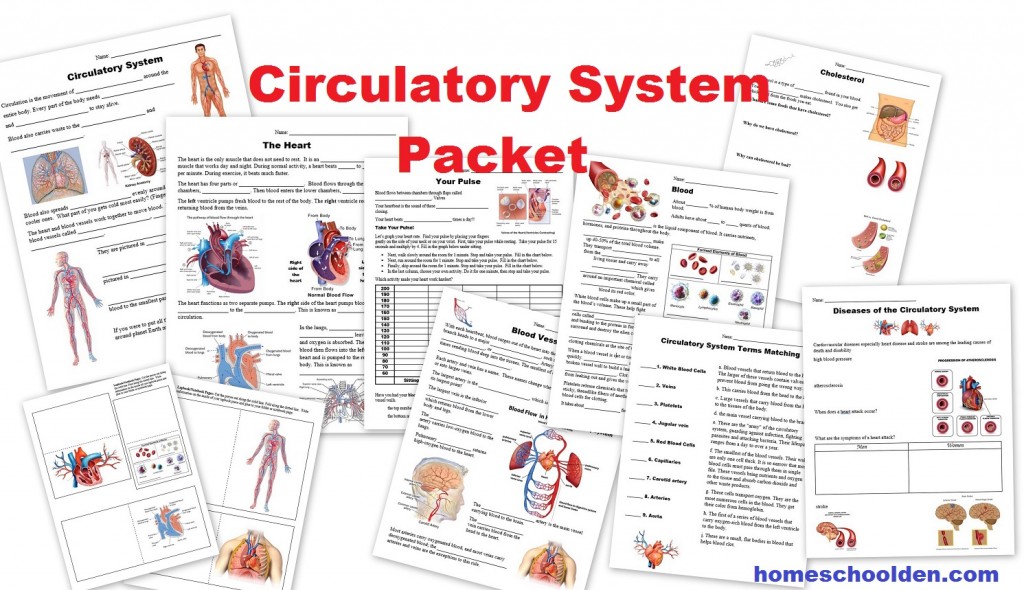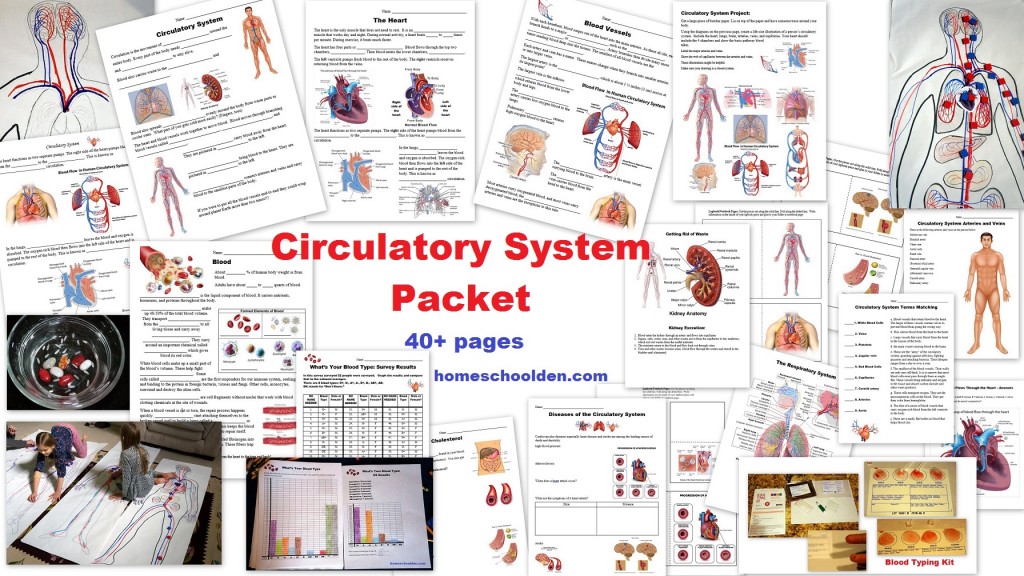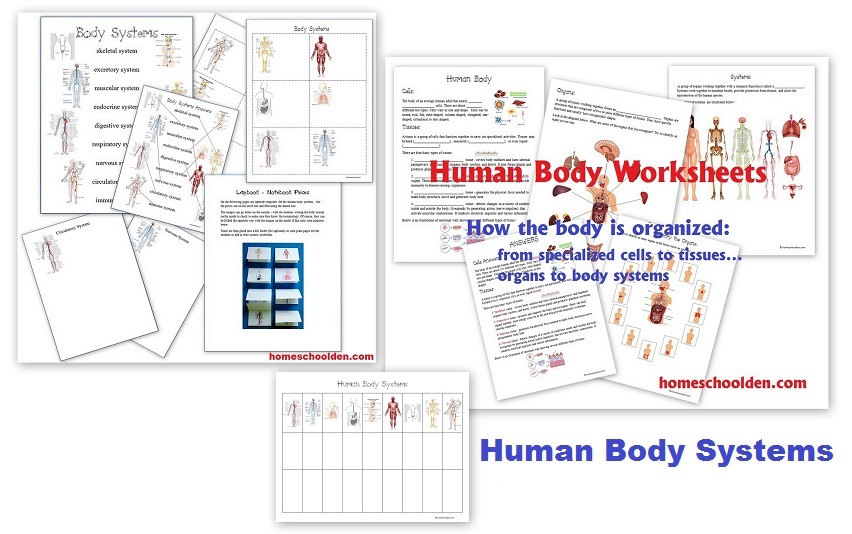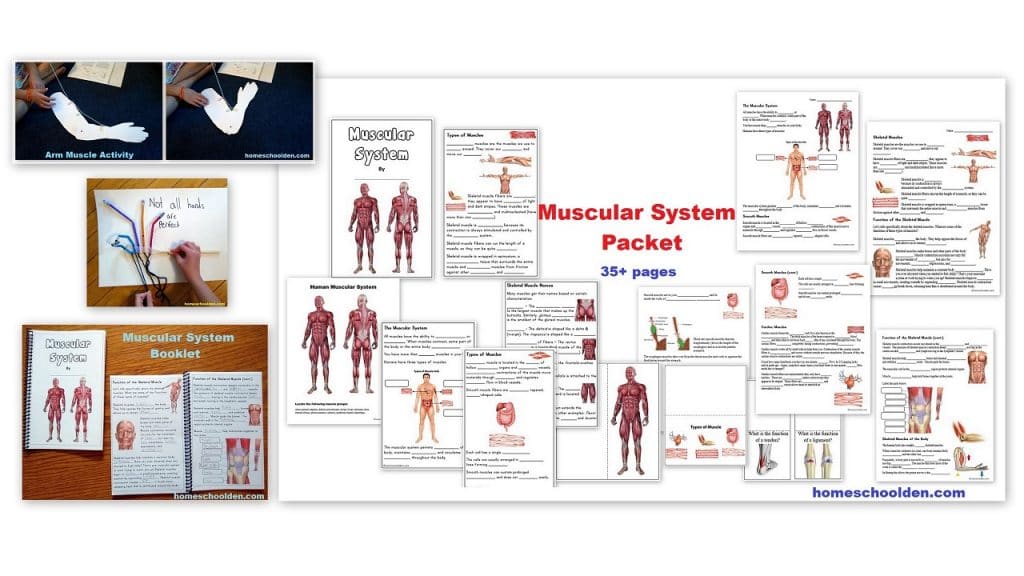
We recently finished up our unit on the circulatory system. Today, I want to share the new Circulatory System Packet which includes the worksheets, notebook pages, and activities we did with this unit. The kids really loved this unit (and learned a lot too!)!
We started off with an overview of the circulatory system before learning about the heart, blood vessels, blood flow through the heart, blood transport through the body, blood composition (red and white blood cells, platelets), blood types, cholesterol, and diseases of the circulatory system. Plus, we did a number of hands-on activities that the kids really loved!
Today, I’m ready to share our packet and some of the hands-on activities that made this unit engaging for the kids! Our Circulatory System Packet is well over 40 pages!
So, here is what this packet includes:

As we started off our unit, we read a couple of books from the library about the circulatory system. We use these books, but anything from the junior non-fiction section would work. (affiliate links)
Then we talked about the circulatory system in general. Over the first couple of days we did the Circulatory System and Heart worksheets (pages 4 and 5).

Once we had talked about the heart, it was time for a hands-on activity. We spent a couple of days practicing how to take our resting pulse rate. I had them find their pulse on their neck and had them count how many beats they could feel in 15 seconds. Then we multiplied that number by 4. We made note of their resting pulse rate.
Another day, the kids found their pulse rate while resting, while walking slowly, while running, while skipping, and then with the activity of their choice. One of my daughters jumped rope. Another ran up and down the stairs for a minute. Then we wound up finding all kinds of activities to do and check our pulse rate. I had the kids graph their results.
This activity was a huge hit!!
Next, we talked about the blood vessels – arteries, veins, and capillaries. One of the activities was to have the kids locate a few of the major veins and arteries (Aortic arch, Renal vein, Femoral artery, Jugular vein, etc.) We had reviewed the skeletal system before starting this unit, so the kids could see how some bones and blood vessels share the same name (like the femoral artery). They located these using the hand-outs you see below (which are in the circulatory system packet).

We then moved on to our big circulatory system project – which took about a week to complete because we worked on it a bit each day.
1. I took a huge piece of butcher paper and made an outline of the kids with pencil (yes, even my 8th grader did this!). The kids then made a dark outline with black marker.
2. Next the kids drew in some of the major organs. They studied some of the hand-outs to help them figure out where these were. I had them do the brain, heart, lungs, stomach and kidneys.
3. The kids used the veins and arteries sheets to help them start sketching in the major paths. I told the kids that they had to have pairs and their artery and vein had to join in a web of capillaries so they could do the activity at the end.
4.The kids then used red markers for the arteries and blue for the veins. The capillaries were webbing of red and blue. At a minimum, the kids had to have arteries/veins that ran to the brain, lungs, hands, and feet. My older two also had some veins/arteries leading to the other organs.

Blood Transport Activity:
We spent quite a bit of time talking about how blood flows through the heart, to the lungs (to pick up oxygen), then goes back to the heart before being pumped out to the body (to drop off oxygen). We spent time looking closely at the heart hand-out (above) and blood flow through the heart. Then we were ready to trace the path blood takes through out bodies.
First, I demonstrated the flow of blood (I go into a lot of detail about the demonstration in the packet – which chamber blood enters from the body before heading to the lungs to pick up oxygen, etc.). Then, the kids did their own blood flow activity starting with 10 blue tiles in the heart… which had to go to the lungs to pick up oxygen (flip to red)… then back to heart before heading to the toes (or brain) to drop of oxygen (flip to blue)… etc. The kids *loved* this!!
What is blood made of:
Next, we went on to talk about what blood is made of.

If your kids are younger, they might enjoy “making” blood
Then, we went on to talk about the different blood types: O+, O-, A+, A-, B+, B-, AB+, AB-

Blood Type Survey:
We surveyed 50 people about their blood types. We made sure to ask only unrelated people (no parents and children) to make the results as random as we could. But if you don’t have time, I included our results and you can use those instead.
Once you have your results, have the kids add up the totals. Then, have your students graph the results, using a different color for each column. Give them the US results and have them graph those results as well, using the same color for each blood type. How did your results compare with the national averages?

Blood Typing Kit
If you are interested, you can purchase a blood-typing kit (affiliate link). Although I know the blood types of my older two, I couldn’t remember the blood type of my youngest. She was eager to have do the blood typing kit even though it entailed pricking her finger!!
The kit includes a comparison chart once your blood has mixed in each of the water droplets. It was pretty straight forward to do!

Finally, we went on to talk about cholesterol and diseases of the circulatory system. We spent time reviewing what we learned in this unit and the kids did the review matching page.
Pages 43-56 of this packet have various lapbook and notebook pages (with various medical images) that you can use with your students if there is different material you want to cover. Plus, there are a couple of pages that touch on getting rid of waste (kidney) and on the respiratory system (lungs), which our family touched on during this unit.

Circulatory System Packet (answer pages are included)
You might want to check out the Human Body BUNDLE options below.
Our packets are PDF digital downloads . After your purchase, remember to check your PayPal email address for the download link. This page answers some Frequently Asked Questions. Feel free to email me if you have any questions! ~Liesl

Don’t forget to check your PayPal email address for the download link.

Disclosure: Please note that some of the links in this post are affiliate links, and at no additional cost to you, I will earn a commission if you decide to make a purchase.
These are some of the packets that are included in our Human Body Bundle.

More pictures provided below!!
These are some of the packets that are included in our Human Body Bundle.
These packets can be purchase separately or you can purchase all of them in one bundle. I included lots of photos of these packets at the Human Body BUNDLE Page.
Our packets are PDF digital downloads . After your purchase, remember to check your PayPal email address for the download link. This page answers some Frequently Asked Questions. Feel free to email me if you have any questions! ~Liesl

$8.99 A Study of Cells Unit (150+pages) Animal and Plant Cells, Cell Theory, Organelles of the Cell, Photosynthesis and More

$4.99 Human Body Systems (50+ pages)

$6.99 Skeletal System Packet (90 pages)

$7.99 Digestive System (150+ pages)

$6.99 Circulatory System Unit (40 pages)

$5.99 Muscular System Unit (50+ pages)

$3.99 Nervous System Packet (20+ pages)

$5.99 Endocrine System Packet – (60 pages) Exocrine glands are those glands that have ducts and lead to the surface of the body… like sweat glands, tear glands whereas endocrine glands (like the hypothalamus or thyroid) secrete hormones into the bloodstream.

$5.99 Five Senses Unit: This 100+ page Five Senses Unit has dozens of hands-on activities and detailed, colorful worksheets for learning all about the five senses – sight & the eye, hearing & the ear, taste & the tongue, smell & the nose, touch & the skin. (NOTE: This unit is NOT included in the Human Body BUNDLE 1 or 2.) Recommended for PreK to Early Elementary. View Post, image 1, image 2, image 3, image 4, image 5

$35.99 Human Body BUNDLE OPTION 1: Human Body Systems, Skeletal System Packet, Digestive System, Circulatory System Unit, Muscular System Packet, Nervous System Packet, Endocrine System, Reproductive System Worksheets (Does not include the Study of Cells Unit or the Five Senses Unit.)

$42.99 Human Body BUNDLE OPTION 2: Human Body Systems, A Study of Cells Unit, Skeletal System Packet, Digestive System, Circulatory System Unit, Muscular System Packet, Nervous System Packet, Endocrine System, Reproductive System Worksheets (We often talked about cells as we started our Human Body Units… then went on to talk about human body cells, tissues, organs & systems… and then would move on to a different body system each year. Generally as homeschoolers, we covered just one or two major body systems each year before moving on to another science topic.) (Does not include the Five Senses Unit.)

$38.99 Human Body BUNDLE OPTION 3: Human Body Systems, Skeletal System Packet, Digestive System, Circulatory System Unit, Muscular System Packet, Nervous System Packet, Endocrine System, Reproductive System Worksheets AND The Five Senses Unit (Does not include the Study of Cells Unit.)

Don’t forget to check your PayPal email address for the download link.
See photos down below or at this Human Body Bundle Page or in Our Store.
If you have any questions, feel free to contact me! ~Liesl
Each year usually in the spring semester, we focus on the human body.
We often spend a little bit of time reviewing what we learned the previous year and then add to what we learned.
If you have younger kids, you might want to just jump right in with the Skeletal System Unit and/or the Digestive System Unit.
Once my kids were a little older (with my youngest in 2 nd grade and my older two in upper elementary) – we started covering and reviewing Cells (the organelles and their function) each year. I want them to feel comfortable with the names and have a general idea of the “jobs” each of these organelles have. By reviewing it each spring, they’ve gradually come to understand how these work together a little better each year. That will be helpful once they get to high school level biology.
If you have a student who is 8+ you might want to do the units in this order:
Note: Since our family studies one major system each year, sometimes we skim over some of this so we can dive in depth into that particular body system.

Here are some screen shots of these units:

$8.99 A Study of Cells Unit



$4.99 Human Body Systems




$6.99 Skeletal System Packet
 Recently updated with new material! This packet is now about 90 pages.
Recently updated with new material! This packet is now about 90 pages.

$5.99 Muscular System Unit (50+ pages)




$7.99 Digestive System


$6.99 Circulatory System Unit (40 pages)


$3.50 Nervous System Packet (20+ pages)



Don’t forget to check your PayPal email address for the download link.
You can visit Our Store to find out more about our other packets!

See you again soon here or over at our Homeschool Den Facebook Page! Don’t forget to Subscribe to our Homeschool Den Newsletter. You might also want to check out some of our resources pages above (such as our Science, Language Arts, or History Units Resource Pages) which have links to dozens of posts. You might want to join our free Homeschool Den Chat Facebook group. Happy Homeschooling, everyone!! ~Liesl